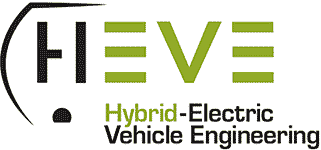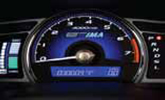Courses:
- Hybrid-Electric Vehicle Powertrains (HEV-PT) - MECH 527 (CRN 70945)
- 3 Credits
- Every Fall semester
- Prerequisites: MECH 307 (Mechatronics)
- Description:
The purpose of this course is to introduce students to the engineering design and analysis of hybrid-electric vehicle (HEV) powertrains. Internal combustion engines have been the prime mover of choice in automobiles for over a century. Increasingly stringent limits on emissions, as well as attention to conservation of hydrocarbon fuels is driving the development of alternative power sources for vehicles, with hybrid-electric powered vehicles rapidly developing as a viable solution. The course is interdisciplinary between ME and ECE – a natural consequence of the technological integration of electrical and mechanical systems inherent in hybrid powertrains; however, students are not expected to have expertise in electrical or mechanical systems.
- Vehicle Energy Storage System (VESS) Design - MECH 523 (CRN 69934)
- 3 credits
- Every Spring semester
- Prerequisites: MECH 331, MECH 536 (Materials courses)
- Description:
This course will consist of 3 five-week modules. Each module will introduce and analyze one technology for electrochemical energy storage. For the first half of each module, Prof. Bradley will provide a detailed introduction to the technology from an electrochemical, thermal, and materials perspective. For the second half of each module, Prof. Bradley will provide a systems-level introduction to relevant applications, sustainability impacts, powerplant design, and application level optimization.
- Plug-In Hybrid Electric Vehicle (PHEV) Computational Systems Design (CSD) - MECH 580A4 (CRN 71043)
- 3 credits
- Every Fall semester
- Prerequisites: MECH 307 (Mechatronics)
- Description:
Although the benefits of the Plug-in Hybrid-Electric Vehicle (PHEV) concept have been validated through modeling and demonstration projects, the impact of vehicle design and control on PHEV performance is not well understood. To date, the models that have been used for PHEV design and modeling are either custom vehicle modeling programs, or else are commercially available programs such as ADVISOR, or PSAT. In general, these programs are designed for fuel economy prediction, hardware in the loop simulation, and low-level powertrain modeling. The limitations of these tools have diminished the role that vehicle design studies have played in defining the characteristics of PHEV designs. For instance, the emphasis on optimization of vehicle fuel economy has excused researchers from modeling and developing the PHEV architectures that are being presently developed by automakers. Whereas nearly all simulated PHEVs have been parallel, ZEV-capable PHEVs, the automakers have been developing range extending and blended mode PHEVs to meet perceived customer requirements for cost, drivability, and reliability.
This course will use the modeling and design languages of Modelica and ModelCenter to perform system level studies of vehicle energy consumption, vehicle use behavior, stochastic economic costs, benefits analyses, and more. This course will present the tools of modeling and optimization of PHEV energy systems, drivelines, and architectures with the goals of developing the skills and techniques that will inform the next generation of innovation for PHEVs.
- Transportation Electrification (TE) - MECH 680A4 (CRN 70576)
- 3 credits
- Every other year, from Fall 2011
- Prerequisites: Graduate standing
- Description:
This course seeks to understand the energy connection between the electrical grid and our personal and public transportation needs. This understanding requires knowledge of the technical, economic, policy, and consumer behavioral aspects of the grid and of personal transportation. Within these contexts, this course will present the tools and techniques for interfacing vehicles to the electrical grid, for quantifying their costs and benefits to the electrical system operators, and for analyzing the commercialization of transportation electrification technologies.



